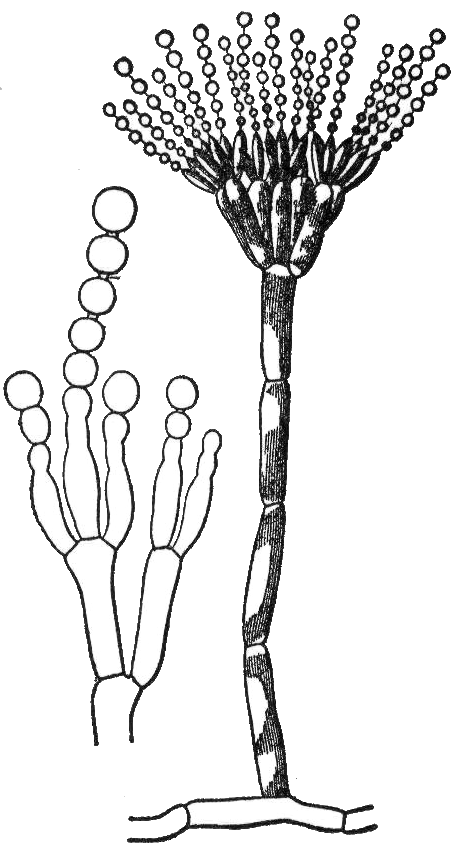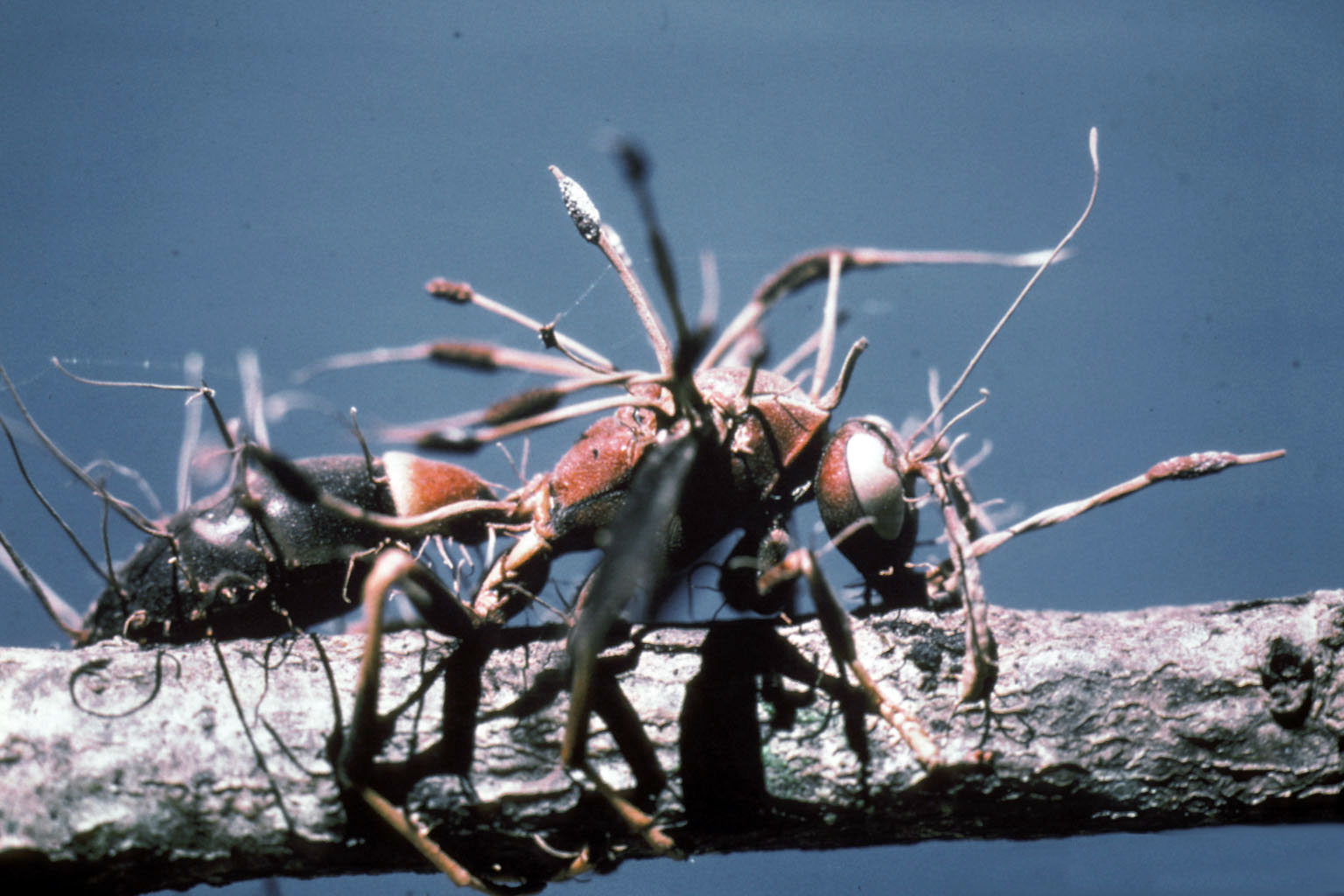|
Entomopathogenic Fungus
Entomopathogenic fungi are parasitic unicellular or multicellular microorganisms belonging to the kingdom of Fungi, that can infect and seriously disable or kill insects. Pathogenicity for insects is widely distributed in the kingdom of fungi and occur in six fungal phyla (Ascomycota, Oomycetes, Basidiomycota, Chytridiomycota, Zygomycota, and Microsporidia). It plays a vital ecological role in controlling insect populations by impacting 19 out of 30 known insect orders. Some fungal entomopathogens are opportunistic whereas some have evolved into highly specific pathogens of insects. Mode of infection Unlike many other insect pathogens (entomopathogenic viruses, nematodes, or bacteria), most entomopathogenic fungi do not require entry through ingestion or oral intake and instead directly attack the insect cuticle and penetrate the insect body through the exoskeleton. These fungi use a broad spectrum of virulence factors such as adhesins (to attach to insect cuticles), lytic enzym ... [...More Info...] [...Related Items...] OR: [Wikipedia] [Google] [Baidu] |
Fungus
A fungus (: fungi , , , or ; or funguses) is any member of the group of eukaryotic organisms that includes microorganisms such as yeasts and mold (fungus), molds, as well as the more familiar mushrooms. These organisms are classified as one of the kingdom (biology)#Six kingdoms (1998), traditional eukaryotic kingdoms, along with Animalia, Plantae, and either Protista or Protozoa and Chromista. A characteristic that places fungi in a different kingdom from plants, bacteria, and some protists is chitin in their cell walls. Fungi, like animals, are heterotrophs; they acquire their food by absorbing dissolved molecules, typically by secreting digestive enzymes into their environment. Fungi do not photosynthesize. Growth is their means of motility, mobility, except for spores (a few of which are flagellated), which may travel through the air or water. Fungi are the principal decomposers in ecological systems. These and other differences place fungi in a single group of related o ... [...More Info...] [...Related Items...] OR: [Wikipedia] [Google] [Baidu] |
Chytridiomycota
Chytridiomycota are a division of zoosporic organisms in the kingdom Fungi, informally known as chytrids. The name is derived from the Ancient Greek ('), meaning "little pot", describing the structure containing unreleased zoospores. Chytrids are one of the earliest diverging fungal lineages, and their membership in kingdom Fungi is demonstrated with chitin cell walls, a posterior whiplash flagellum, absorptive nutrition, use of glycogen as an energy storage compound, and synthesis of lysine by the -amino adipic acid (AAA) pathway. Chytrids are saprobic, degrading refractory materials such as chitin and keratin, and sometimes act as parasites. There has been a significant increase in the research of chytrids since the discovery of '' Batrachochytrium dendrobatidis'', the causal agent of chytridiomycosis. Classification Species of Chytridiomycota have traditionally been delineated and classified based on development, morphology, substrate, and method of zoospore disch ... [...More Info...] [...Related Items...] OR: [Wikipedia] [Google] [Baidu] |
Animal Fungal Diseases
Animals are multicellular, eukaryotic organisms in the biological kingdom Animalia (). With few exceptions, animals consume organic material, breathe oxygen, have myocytes and are able to move, can reproduce sexually, and grow from a hollow sphere of cells, the blastula, during embryonic development. Animals form a clade, meaning that they arose from a single common ancestor. Over 1.5 million living animal species have been described, of which around 1.05 million are insects, over 85,000 are molluscs, and around 65,000 are vertebrates. It has been estimated there are as many as 7.77 million animal species on Earth. Animal body lengths range from to . They have complex ecologies and interactions with each other and their environments, forming intricate food webs. The scientific study of animals is known as zoology, and the study of animal behaviour is known as ethology. The animal kingdom is divided into five major clades, namely Porifera, Ctenophora, Placozo ... [...More Info...] [...Related Items...] OR: [Wikipedia] [Google] [Baidu] |
Desert Locust
The desert locust (''Schistocerca gregaria'') is a species of locust, a periodically swarming, short-horned grasshopper in the family Acrididae. They are found primarily in the deserts and dry areas of northern and eastern Africa, Arabia, and southwest Asia. During population surge years, they may extend north into parts of Southern Europe, south into Eastern Africa, and east in northern India. The desert locust shows periodic changes in its body form and can change in response to environmental conditions, over several generations, from a solitary, shorter-winged, highly fecund, non-migratory form to a gregarious, long-winged, and migratory phase in which they may travel long distances into new areas. In some years, they may thus form locust plagues, invading new areas, where they may consume all vegetation including crops, and at other times, they may live unnoticed in small numbers. During plague years, desert locusts can cause widespread damage to crops, as they are highly ... [...More Info...] [...Related Items...] OR: [Wikipedia] [Google] [Baidu] |
LUBILOSA
LUBILOSA was the name of a research program management, programme that aimed at developing biological pest control, a biological alternative to the insecticide, chemical control of locusts. This name is an acronym of the French language, French title of the programme: Lutte Biologique contre les Locustes et les Sauteriaux (biological pest control, biological control of locusts and grasshoppers). During its 13-year life (November 1989 to December 2002), the programme identified an Genetic isolate, isolate of an entomopathogenic fungus belonging to the genus ''Metarhizium'' and virulence, virulent to locusts, and went through all the necessary steps to develop the commercial Biological insecticide, biopesticide product ''Green Muscle'' based on its spores. Collaborators The programme was conceived by Chris Prior and :species:David J. Greathead, David Greathead of the International Institute of Biological Control (IIBC), a former research institute of CAB International that was based ... [...More Info...] [...Related Items...] OR: [Wikipedia] [Google] [Baidu] |
Biopesticide
A biopesticide is a biological substance or organism that damages, kills, or repels organisms seens as pests. Biological pest management intervention involves predatory, parasitic, or chemical relationships. They are obtained from organisms including plants, bacteria and other microbes, fungi, nematodes, ''etc''. They are components of integrated pest management (IPM) programmes, and have received much practical attention as substitutes to synthetic chemical plant protection products (PPPs). Definitions Regulatory positions can be influenced by public perceptions, thus: * the EU, defines biopesticides as "a form of pesticide based on micro-organisms or natural products". * the US EPA states that they "include naturally occurring substances that control pests (biochemical pesticides), microorganisms that control pests (microbial pesticides), and pesticidal substances produced by plants containing added genetic material (plant-incorporated protectants) or PIPs". Types Biopesti ... [...More Info...] [...Related Items...] OR: [Wikipedia] [Google] [Baidu] |
Cephalonomia Tarsalis
''Cephalonomia tarsalis'' is a idiobiont parasitoid, ectoparasitoid hymenopteran in the family Bethylidae. Known hosts include: ''Oryzaephilus surinamensis'', ''Sitophilus granarius'', ''Sitophilus oryzae'', ''Sitophilus zeamais'', and ''Tribolium castaneum''. Biology On ''Oryzaephilus surinamensis'', fertilized females ''C. tarsalis'' lay on average 85 eggs and non-fertilized females lay on average 50 eggs. Adult lifespan is on average 35 days for females and 6 days for males at room temperature. Adult females need to host-feed to initiate oviposition. Upon paralyzing a host (a beetle larva or pupa) the female typically lays 2 eggs (one female and one male) onto the host's body. When 2 larvae develop on the same host they develop on average in 2/3 the time required for a solitary larva to develop. The life cycle is completed in ~20 days at room temperature on ''Oryzaephilus surinamensis''. Cocoons can overwinter. Males emerge 2 days prior to females. Males enter the cocoon of ... [...More Info...] [...Related Items...] OR: [Wikipedia] [Google] [Baidu] |
Parasitism
Parasitism is a close relationship between species, where one organism, the parasite, lives (at least some of the time) on or inside another organism, the host, causing it some harm, and is adapted structurally to this way of life. The entomologist E. O. Wilson characterised parasites' way of feeding as "predators that eat prey in units of less than one". Parasites include single-celled protozoans such as the agents of malaria, sleeping sickness, and amoebic dysentery; animals such as hookworms, lice, mosquitoes, and vampire bats; fungi such as honey fungus and the agents of ringworm; and plants such as mistletoe, dodder, and the broomrapes. There are six major parasitic strategies of exploitation of animal hosts, namely parasitic castration, directly transmitted parasitism (by contact), trophicallytransmitted parasitism (by being eaten), vector-transmitted parasitism, parasitoidism, and micropredation. One major axis of classification concerns invasiveness: ... [...More Info...] [...Related Items...] OR: [Wikipedia] [Google] [Baidu] |
Conidium
A conidium ( ; : conidia), sometimes termed an asexual chlamydospore or chlamydoconidium (: chlamydoconidia), is an Asexual reproduction, asexual, non-motility, motile spore of a fungus. The word ''conidium'' comes from the Ancient Greek word for dust, ('). They are also called mitospores due to the way they are generated through the cellular process of mitosis. They are produced exogenously. The two new haploid cells are genetically identical to the haploid parent, and can develop into new organisms if conditions are favorable, and serve in biological dispersal. Asexual reproduction in ascomycetes (the phylum Ascomycota) is by the formation of conidia, which are borne on specialized stalks called conidiophores. The Morphology (biology), morphology of these specialized conidiophores is often distinctive between species and, before the development of molecular techniques at the end of the 20th century, was widely used for identification of (''e.g.'' ''Metarhizium#Species, Metarh ... [...More Info...] [...Related Items...] OR: [Wikipedia] [Google] [Baidu] |
Metarhizium
''Metarhizium'' is a genus (biology), genus of entomopathogenic fungus, entomopathogenic fungi in the family Clavicipitaceae. With the advent of genetic profiling, placing these fungi in proper taxa has now become possible. Most turn out to be the asexual forms (anamorphs) of fungi in the phylum Ascomycota, including ''Metacordyceps'' spp. Species Before molecular techniques were introduced at the end of the 20th century, ''Metarhizium'' species were identified on morphological (notably Conidium, conidial) characteristics. The 'original' species included: ''Metarhizium anisopliae, M. anisopliae'' (with ''Metarhizium majus, M.a. var. major''), ''Metarhizium brunneum, M. brunneum'', ''Metarhizium cicadinum, M. cicadinum'', ''Metarhizium cylindrosporum, M. cylindrosporum'', ''Metarhizium flavoviride, M. flavoviride'', ''Metarhizium taii, M. taii'', ''Metarhizium truncatum, M. truncatum'', and ''Metarhizium viridicolumnare, M. viridicolumnare''. In 2009, nine former varieties ... [...More Info...] [...Related Items...] OR: [Wikipedia] [Google] [Baidu] |
Beauveria Bassiana
''Beauveria bassiana'' is a fungus that grows naturally in soils throughout the world and acts as a parasite on various arthropod species, causing white muscardine disease; it thus belongs to the group of entomopathogenic fungi. It is used as a biological insecticide to control a number of pests, including termites, thrips, whiteflies, aphids and various beetles. Its use in the control of bed bugs and malaria-transmitting mosquitos is under investigation.Donald G. McNeil Jr.Fungus Fatal to Mosquito May Aid Global War on Malaria ''The New York Times'', 10 June 2005 Taxonomy The species is named after the Italian entomologist Agostino Bassi, who discovered it in 1835 in silkworms (''Bombyx mori''). Bassi performed the first infection experiments, and determined the fungus to be the cause of the muscardine disease, which then led to carriers transmitting it by airborne means. Later the same year, the fungus was named ''Botrytis bassiana'' by Giuseppe Gabriel Balsamo-Crivelli. The ... [...More Info...] [...Related Items...] OR: [Wikipedia] [Google] [Baidu] |
Cordyceps
''Cordyceps'' is a genus of ascomycete fungi (sac fungi) that includes over 260 species worldwide, many of which are parasitic. Diverse variants of cordyceps have had more than 1,500 years of use in Chinese medicine. Most ''Cordyceps'' species are endoparasitoids, parasitic mainly on insects and other arthropods (they are thus entomopathogenic fungi); a few are parasitic on other fungi. The generic name ''Cordyceps'' is derived from the ancient Greek κορδύλη ''kordýlē'', meaning "club", and the Latin ''-ceps'', derived from Latin ''caput'', meaning "head". The genus has a worldwide distribution, with most of the known species being from Asia. Taxonomy There are two recognized subgenera: *''Cordyceps'' subgen. ''Cordyceps'' Fr. 1818 *''Cordyceps'' subgen. ''Cordylia'' Tul. & C. Tul. 1865 ''Cordyceps'' sensu stricto are the teleomorphs of several genera of anamorphic, entomopathogenic fungi such as '' Beauveria'' ('' Cordyceps bassiana''), '' Septofusidium'' ... [...More Info...] [...Related Items...] OR: [Wikipedia] [Google] [Baidu] |







